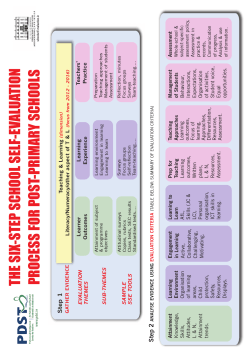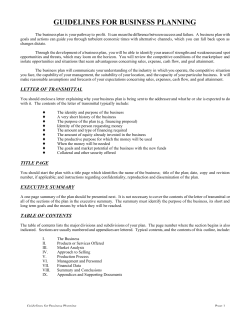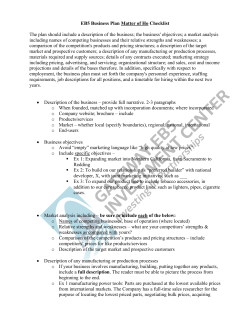
The Business Plan
The Business Plan A business plan is a tool that can help you in many ways. It can: Help you organize your thoughts and ideas about your business. Act as a written guideline by which to operate your business. Explain the key elements of your business to someone from whom you want a loan. The first thing to note about business plans is that they should be well written. The best business plans are those that are clear, concise, and easy to read. Making sure your plan is easy to read helps whoever is reading it to find the information they need, and also prevents misunderstandings. A business plan should also address everything that is important about your business. A business plan can be as long or short as needed, so be sure to include all necessary details. Do not omit something of importance in order to save space. Be sure to include a Title Page to your plan. The Title Page should be attractive and easy to read. It must have the name of your product/service, as well as the name of your company. It should also be marked CONFIDENTIAL. The most important part of a business plan is the Executive Summary. The Executive Summary tells your reader in 1-2 pages, all the important details about your business. The Executive Summary is the last section you write in the plan (because it is a summary), but it is located at the beginning of your plan. The second most important part of a business plan is the Financial Plan. The Financial Plan clearly maps your expectations for sales, revenues, expenses, profits, and cash flow. It also explains how you formulated your expectations for these numbers, and how circumstances could affect your overall financial picture. All the other parts of your business, such as your Product / Service, Marketing Plan, Operating Plan, etc., are detailed in separate sections. In addition to clearly describing all of the details pertaining to each area of your business, a business plan should address your strengths and weaknesses. By recognizing what your strengths and weaknesses are, you can make plans based on utilizing your strengths, and overcoming your weaknesses. As a business grows and changes, it becomes necessary to adjust the business plan to fit the new needs of the business. The basic outline of the plan stays the same, but the information inside changes. The Executive Summary The Executive Summary is the most important part of your business plan. It tells your reader who you are, what you do, how much money you need, why, and how you will repay it. Your reader should be able to read your summary in five minutes and fully understand your business. Keep in mind an Executive Summary should: Be clear and concise Be 1 - 2 pages in length Represent you and your business well. A. Briefly describe your company, including: 1. Company name 2. Management structure a. Type of company (sole proprietorship, partnership, corporation). b. Names of owner and/or managers. 3. Product/Service 4. Distinct functions of your business 5. Mission and Motto B. Briefly discuss your product/service, including: 1. Unique characteristics 2. Stage of development, and any pertinent development history 3. Your target market a. Demographics b. Customers needs you will fulfil c. What will motivate your customer to buy your product/service 4. Selling strategies 5. Pricing strategies 6. Competition a. Strengths and weaknesses b. How you will compete C. Outline your need for financing, including: 1. How much money you need 2. What it is for (be specific) 3. Any assets you can use as collateral 4. How much money you, or other partners and/or investors have invested to date. D. Present a Plan for paying back your financing, including: 1. When the repayment will begin 2. What your payments will be 3. How often they will be 4. How much interest you will pay 5. How you will make the payments (where will the money come from) E. Summarize what makes the Deal "special": 1. Briefly state (in one or two sentences) why it is a "good deal" to invest in your business. 2. Be sure to point out the positives, such as safe investment, high rate of return, etc. Table of Contents The Table of Contents lays out the order of topics in your business plan, and makes it easy for your reader to search for information. The Table of Contents should: Include all topic areas in you plan. Use main headings and subsections to organize topics. Be clear, easy to read, and easy to understand. Using the headings and subsections of this plan, your Table will resemble the following: Executive Summary 1. The Company A. Description B. Mission and Motto C. Management D. Goals Pg. 5 Pg. 5 Pg. 5 Pg. 6 Pg. 6 2. The Product/Service A. Description B. Selling Features C. Strengths and Weaknesses Pg. 7 Pg. 7 Pg. 7 Pg. 7 3. The Industry A. Description B. Competition C. Strengths and Weaknesses Pg. 8 Pg. 8 Pg. 9 Pg. 9 4. The Marketing Plan A. Target Market B. Secondary Markets C. Selling Strategies D. Pricing Strategies E. Strengths and Weaknesses Pg. 10 Pg. 10 Pg. 11 Pg. 12 Pg. 13 Pg. 14 5. The Operating Plan A. Location B. Equipment C. Staff D. The Process E. Strengths and Weaknesses Pg. 15 Pg. 15 Pg. 15 Pg. 16 Pg. 17 Pg. 18 6. The Financial Plan A. Capital Required B. Repayment Schedule C. Assumptions D. Income Statements E. Cash Flow Statements F. Balance Sheets Pg. 19 Pg. 19 Pg. 20 Pg. 21 Pg. 22 Pg. 23 Pg. 24 7. Appendix A. Management Resume(s) B. Picture(s) of Product, Location, etc. A1 A2 The Company This section should tell your reader everything of importance about your company. A. Description 1. Company Name 2. Legal Description a. Type of Company - if you own it yourself, or are in a partnership, the company is called a proprietorship. Tell your reader if it is a sole proprietorship (one owner), or a double proprietorship. If you are incorporated, your company is called a corporation. b. When and where the company was formed. 3. Purpose a. Brief description of what your company does -one line only b. The type of business you are (i.e. manufacturer, retailer, etc.) c. The services you provide. B. Mission and Motto 1. Present your Mission Statement, and explain how it reflects the values and goals of your company. a. A mission statement is a statement that describes what your company wants to accomplish. It encompasses your goals, and the way you conduct your business. (Ex. To ensure that our customers' needs are fully satisfied through providing them with individualized service, the best quality products, and peace of mind.) 2. Present your motto, and explain how it represents your product and/or company. a. (Ex. "It's Always Better at Grandma's Diner"- represents your company; "We put the rock in rockinghorse" - represents your product; "Service that feels as good as the flannel we sell" - represents both.) C. Management 1. Who the owner(s)/manager(s) are in your company. 2. Describe what each person's responsibilities will be in your company. 3. Give a brief background for each person, highlighting the skills and experience that will be valuable to your business. 4. Name any other key people in the company and their role(s), including advisors and consultants. D. Goals 1. Short Term Goals - explain what your company's goals are for the next year. 2. Long Term Goals - explain what your company's goals are for the next three years, five years, and ten years. The Product / Service This section should clearly identify what your product / service is, and what it's benefits are to your customer. You must describe all the unique features and/or characteristics of your product/service. Be sure to: Use understandable language. (Don't use technical terms or jargon to describe and explain your product / service.) Fully explain the features and benefits of your product / service. Don't be too broad, or assume that your reader already knows something about your product / service. A. Description 1. Give the name of your product / service. 2. Give the function(s) of your product / service. 3. Describe the features of your product / service and how they work. a. Detail what materials your product is made of, and how it is produced. b. Describe what stage of development the product is in, and any history the product/service has. c. Give dimensions, measurements, size, shape, colour(s), design, life span, etc. d. Identify the product's "shelf life" (i.e. is it's demand due to a current trend, or will there be a constant need, and constant demand in the long term?). e. If your product is patented, or has patent protection, discuss its legal status and how you, as the seller, are protected. f. Describe any government approvals obtained for your product/service, and the length of time for which they are valid. g. Describe any potential liabilities you have due to your product/service, and the precautions you will take for them. 4. Describe how you product will be produced. a. Give information about the manufacturing of your product including whom the manufacturer is, where they are located, and any special materials and/or processes involved in its production. b. Explain any effects changing technology and/or trends may have on your product. Will it have to undergo further development? c. Describe any plans for the development of "spin-off" products/services in the future. 5. Describe any standards of service and/or quality you intend to follow in the production or execution of your product/service. B. Selling Features 1. Explain the need or desire for your product / service. a. Describe the needs your product/service will fulfil, or the problems it will solve. b. Explain what will motivate your customers to buy your product/service. 2. Discuss the benefits of your product / service to your customers. a. Unique features (how is your product/service different and/or better than what is already available). b. Location (where you sell the product or provide the service, if you deliver, etc.) c. Hours of operation d. Warranty, etc. C. Strengths and Weaknesses 1. Describe the strengths of your product / service. 2. Describe the weaknesses of your product / service, and how you will deal with them. The Industry This section describes the industry your company will compete in. Your reader needs to know if demand in this industry is growing, if there are any trends that will affect your business, and who your competitors are, and how they will affect your business. You need to show how you are going to fit into this industry. A. Description 1. Name the industry and what products / services it typically provides. 2. Give a brief description of the customers in this industry. 3. Describe the size of this industry. a. Number of competitors there are (businesses selling the same, or a similar product / service as your company). b. Geographical area the industry covers. c. Number of customers there are (approximate). d. How many dollars consumers spend in this industry per year. 4. Describe any trends in this industry. a. Seasonal or cyclical trends (sales that change due to seasonal changes such as weather, holidays, etc.) b. Past trends that affected the industry. c. Future anticipated trends that could affect the industry. 5. Describe any government involvement in this industry, and how it could affect you. B. Competition 1. Give a more detailed account of the number of competitors in this industry. a. Who the major competitors are (by product and geographic area). b. How much of the industry they currently control. c. How long they have been in this industry. d. What their strengths and weaknesses are. e. Chances that more competition will enter the industry. 2. Explain how you will compete in this industry. a. How you will establish yourself initially. b. What your long-term plans are for competing. c. What you will do if the competition threatens you position (through lowering their prices, improving their service, developing other products/services, etc.) 3. Describe any indirect competition (competition from companies with a different product / service, but who cater to the same customer as you), and how you will deal with it. C. Strengths and Weaknesses 1. Describe the current strengths and weaknesses of this industry. 2. Describe how your company will build on these strengths, and work to eliminate some of the weaknesses. a. Outline your advantages in this industry. b. Describe your weaknesses, and how you will deal with them. The Marketing Plan This section tells your reader more specifically to whom you are going to sell your product / service, and how. Do not make the following assumptions: That a product or service can "sell itself". That you can capture the entire market. That you only need to capture a small part of a very large market. That you can serve many different, unrelated markets with the same marketing strategy. That sales will increase simply by decreasing your selling price. That product brand names, and service names, are not important. A. Target Market 1. Describe your target market. (Your target market is the group of customers you want to sell the most to. They are your focal point. They are the group that is most likely to buy your product / service.) a. Detail the common demographic characteristics of your target market - i.e. age, income, gender, location, buying patterns, etc. (Include any research you have done) b. Describe why you are targeting this market. c. Describe the psychographic "needs" of this market (i.e. the need for security, love, selfesteem, independence, acceptance, etc.) 2. Describe why your target market is most likely to purchase your product / service. (How are you serving their needs and characteristics?) B. Secondary Markets 1. Describe all your secondary markets. (Your secondary markets are the groups of customers you will also sell to. They are not your focal point. These customers have different reasons for buying your product than your target market, and usually respond to different marketing or product / service features than your target market.) a. Name your secondary markets. b. Detail the common demographic characteristics of your secondary markets. (Include any research you have done) c. Describe the psychographic "needs" of your secondary markets. 2. Describe why these secondary markets are likely to purchase your product / service. C. Selling Strategies 1. Describe your selling strategies. a. How you are going to promote your product / service. This may include: Niche marketing (promoting your product / service as specifically suited for a certain need or purpose, rather than for many needs) Based on certain features or unique characteristics of your product / service. Based on high quality customer service. As a new product / service; something not already on the market. b. Describe the methods you will use to sell your product / service. Advertising, Brochures, Press Releases. etc. Include expected costs for these, as well as who will design them. c. Compare your promotion methods with those of the competition. Describe why you chose your method of marketing and advertising compared to what the competition is doing. 2. Describe how you will "track" your sales. How will you decide if your promotion and marketing has been successful? The Marketing Plan Cont'd: D. Pricing Strategies 1. Describe your pricing strategies. a. Describe what your prices will be (include a pricing sheet). b. Explain how you determined the prices you will charge. Give the standard method of pricing for you industry (i.e. percentage of cost, what the customer will pay, etc.) 2. Where your prices will be compared to those of your competitors. a. How these prices will place you. Lower price - a better deal, but may be seen as less quality. Average price - sell your product / service based on features rather than price competition. Higher price - more expensive than the competition, but may be seen as higher quality. b. Explain any strategy you will use to compete using prices. E. Strengths and Weaknesses 1. Describe the strengths of your marketing plan. 2. Describe the weaknesses of your marketing plan, and how you will deal with them. The Operating Plan This section tells your reader how you will operate your business. It details how many staff you will need, where you will locate, any equipment and/or special processes you will use, and your general expectations in how you will provide your product / service. A. Location 1. Give full details regarding your location. a. The physical address, and a description of the area. b. Total square footage. c. Amount of parking (free or paid?). d. Other addresses if you will be in more than one location. e. Type of space (office, warehouse, both, etc.) f. Cost (Rental or purchase). g. Expected length of time in that location. 2. Discuss the advantages and disadvantages of your location. B. Equipment 1. Outline and describe any significant equipment you will use (including vehicles, office equipment, manufacturing equipment, etc.). a. What it is for. b. Production capabilities. c. Cost. (Rental or purchase) d. Space and electrical requirements. C. Staff 1. Describe how many staff you will need, including: a. Their duties. b. How you will recruit them. c. What education, experience, etc. you will require them to have. d. How much you will pay them (including benefits, etc.) e. How many hours they will work, and when. *** If you will be the only person employed, clearly explain how you will handle all of the work involved in operating your business. 2. Describe what your expectations for staffing will be in the future. If you anticipate needing more staff, explain using the criteria from above. D. Process 1. If providing a product, explain any and all manufacturing processes you must undertake in order to produce your product. a. Explain process from raw materials to finished product. b. Where you get raw materials from, their cost, etc. c. Time, staff, and equipment involved. d. In the case of sub-contracting, describe what work you will hire sub-contractors for. Give the terms of their contract. State how you will ensure they provide you with quality work. 2. Outline your key suppliers. a. Advantages to dealing with these suppliers. b. Disadvantages to dealing with these suppliers. The Operating Plan Cont'd: 3. Outline any inventory issues you may need to deal with. a. The amount of inventory you need to have on hand. b. Where you will store it. c. How you will keep track of it. d. The lead-time you will need in ordering it. e. Terms regarding the return of inventory (can you return items that do not sell, items you ordered too many of, etc.) f. Any inventory issues arising from making out-of-country purchases (such as duties, brokers, etc.) 4. Outline your methods for ensuring Quality Control. a. Define your expectations in terms of quality. b. Methods of checking for quality. c. Describe any procedures (forms, meetings, etc.) you will use to ensure quality in your product/service and operations. E. Strengths and Weaknesses 1. Discuss the strengths of your Operating plan. 2. Discuss the weaknesses, and how you will deal with them. The Financial Plan This section of your plan is very important to your reader. It shows what you expect your business to produce in terms of revenues, expenses, and cash flow. This section also explains how much money you need to borrow, and why. Most importantly, this section must show how you will repay any loans you receive. It is important to do the following: Fully explain all of your numbers. Be clear and accurate. Be flexible; have back-up plans in the event that your predictions for revenues and/or expenses are wrong. A. Capital Required 1. Clearly explain how much money you need to borrow. a. Amount of money required. b. What it is needed for. (Be specific) c. Amount of money/capital you already have invested into the business. (If you have money or loans from other sources, detail them here.) Amount. From where. Terms (how long, interest rates, etc.) 2. List any liabilities you have outstanding (including GST, income tax, payroll deductions, etc.) 3. List any assets (and their worth) that you are willing to use as security for a loan. You may also include guarantees and other forms of security. B. Repayment Schedule 1. Describe your plans for repayment of the capital required. a. Describe the benefits of investing in your company (Interest rate you will give, bonuses, part ownership of company, etc.) b. Detail the length of time you require for repayment. c. Describe how you will repay the investment (i.e. monthly payments, quarterly payments, etc.) 2. Describe your contingency plan in the event that you cannot meet the obligations of your primary repayment schedule. C. Assumptions 1. Clearly explain all the assumptions you are using in deriving your calculations. (These can include the number of sales you expect to have, the costs of your expenses, the rate at which you expect your revenues to increase/decrease, etc.) a. Explain what your assumptions are. b. Explain why these are your assumptions, and any research you have to support them. c. Describe any changes that may affect your assumptions (trends, new legislation, recession, etc.), and how these would affect your financial picture. D. Income Statements 1. Provide monthly Income Statements for the first year. Be sure to explain any large changes, and/or large sales volumes. E. Cash Flow Statements 1. Provide monthly Cash Flow projections for the first year. (These correspond to your Income Statements). These are an estimate of when the dollars associated with sales will actually be received, and when the dollars associated with expenses will actually be paid. F. Balance Sheets 1. Provide a Balance Sheet for Opening and Year-End. Appendix This section contains any supporting data, research, or promotional materials that benefit your business plan. When using an appendix, refer to its contents in your business plan. For example, you may describe your promotional materials in your marketing plan, and refer your reader to see an example of them in the appendix. - "We will use 8.5 x 11" flyers to advertise our service. They will be bright orange with large print, and will be distributed by hand at local flea markets. Please refer to A4 of the Appendix to see sample." Your appendix may include any of the following: Management Resumes. Pictures of your product, location, company vehicles, etc. Marketing materials. Market research and/or surveys. Floor plans and layout. Pictures and details for special equipment, machinery, etc. Break Even Analysis. A Critical Path Diagram (timeline of events for your business complete with dates - used for measuring results) Copies of contracts, leases, shareholder or partnership agreements, franchise information and agreements, letters of intent, purchase orders, etc. Any other supporting documentation or pictures. Number the pages of your appendix beginning with the number 1, and prefix them with a capital A. For example, A1, A2, A3, etc. Also be sure to provide a title or headline describing what is on each page.
© Copyright 2025



















